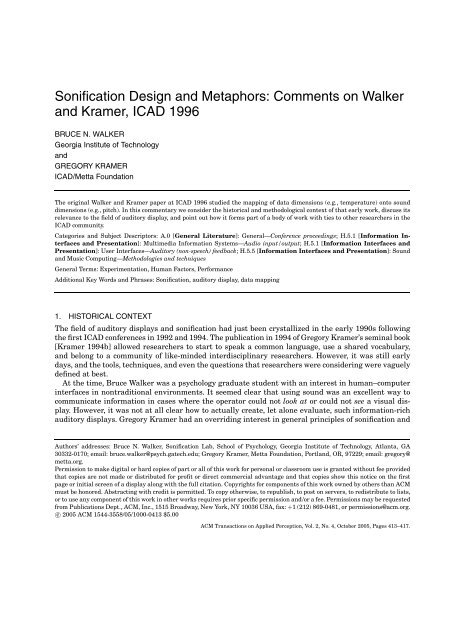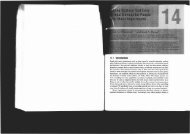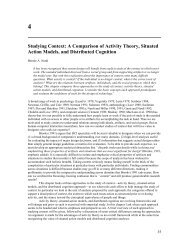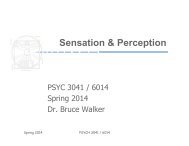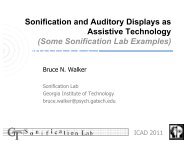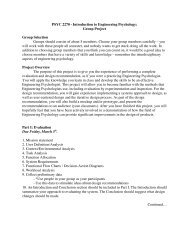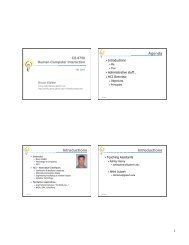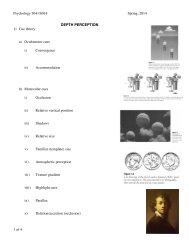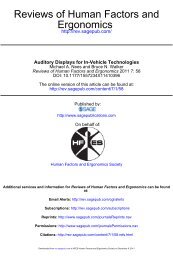Comments on Walker and Kramer - Georgia Tech Sonification Lab
Comments on Walker and Kramer - Georgia Tech Sonification Lab
Comments on Walker and Kramer - Georgia Tech Sonification Lab
Create successful ePaper yourself
Turn your PDF publications into a flip-book with our unique Google optimized e-Paper software.
S<strong>on</strong>ificati<strong>on</strong> Design <strong>and</strong> Metaphors: <str<strong>on</strong>g>Comments</str<strong>on</strong>g> <strong>on</strong> <strong>Walker</strong><strong>and</strong> <strong>Kramer</strong>, ICAD 1996BRUCE N. WALKER<strong>Georgia</strong> Institute of <strong>Tech</strong>nology<strong>and</strong>GREGORY KRAMERICAD/Metta Foundati<strong>on</strong>The original <strong>Walker</strong> <strong>and</strong> <strong>Kramer</strong> paper at ICAD 1996 studied the mapping of data dimensi<strong>on</strong>s (e.g., temperature) <strong>on</strong>to sounddimensi<strong>on</strong>s (e.g., pitch). In this commentary we c<strong>on</strong>sider the historical <strong>and</strong> methodological c<strong>on</strong>text of that early work, discuss itsrelevance to the field of auditory display, <strong>and</strong> point out how it forms part of a body of work with ties to other researchers in theICAD community.Categories <strong>and</strong> Subject Descriptors: A.0 [General Literature]: General—C<strong>on</strong>ference proceedings; H.5.1 [Informati<strong>on</strong> Interfaces<strong>and</strong> Presentati<strong>on</strong>]: Multimedia Informati<strong>on</strong> Systems—Audio input/output; H.5.1 [Informati<strong>on</strong> Interfaces <strong>and</strong>Presentati<strong>on</strong>]: User Interfaces—Auditory (n<strong>on</strong>-speech) feedback; H.5.5 [Informati<strong>on</strong> Interfaces <strong>and</strong> Presentati<strong>on</strong>]: Sound<strong>and</strong> Music Computing—Methodologies <strong>and</strong> techniquesGeneral Terms: Experimentati<strong>on</strong>, Human Factors, PerformanceAdditi<strong>on</strong>al Key Words <strong>and</strong> Phrases: S<strong>on</strong>ificati<strong>on</strong>, auditory display, data mapping1. HISTORICAL CONTEXTThe field of auditory displays <strong>and</strong> s<strong>on</strong>ificati<strong>on</strong> had just been crystallized in the early 1990s followingthe first ICAD c<strong>on</strong>ferences in 1992 <strong>and</strong> 1994. The publicati<strong>on</strong> in 1994 of Gregory <strong>Kramer</strong>’s seminal book[<strong>Kramer</strong> 1994b] allowed researchers to start to speak a comm<strong>on</strong> language, use a shared vocabulary,<strong>and</strong> bel<strong>on</strong>g to a community of like-minded interdisciplinary researchers. However, it was still earlydays, <strong>and</strong> the tools, techniques, <strong>and</strong> even the questi<strong>on</strong>s that researchers were c<strong>on</strong>sidering were vaguelydefined at best.At the time, Bruce <strong>Walker</strong> was a psychology graduate student with an interest in human–computerinterfaces in n<strong>on</strong>traditi<strong>on</strong>al envir<strong>on</strong>ments. It seemed clear that using sound was an excellent way tocommunicate informati<strong>on</strong> in cases where the operator could not look at or could not see a visual display.However, it was not at all clear how to actually create, let al<strong>on</strong>e evaluate, such informati<strong>on</strong>-richauditory displays. Gregory <strong>Kramer</strong> had an overriding interest in general principles of s<strong>on</strong>ificati<strong>on</strong> <strong>and</strong>Authors’ addresses: Bruce N. <strong>Walker</strong>, S<strong>on</strong>ificati<strong>on</strong> <strong>Lab</strong>, School of Psychology, <strong>Georgia</strong> Institute of <strong>Tech</strong>nology, Atlanta, GA30332-0170; email: bruce.walker@psych.gatech.edu; Gregory <strong>Kramer</strong>, Metta Foundati<strong>on</strong>, Portl<strong>and</strong>, OR, 97229; email: gregory@metta.org.Permissi<strong>on</strong> to make digital or hard copies of part or all of this work for pers<strong>on</strong>al or classroom use is granted without fee providedthat copies are not made or distributed for profit or direct commercial advantage <strong>and</strong> that copies show this notice <strong>on</strong> the firstpage or initial screen of a display al<strong>on</strong>g with the full citati<strong>on</strong>. Copyrights for comp<strong>on</strong>ents of this work owned by others than ACMmust be h<strong>on</strong>ored. Abstracting with credit is permitted. To copy otherwise, to republish, to post <strong>on</strong> servers, to redistribute to lists,or to use any comp<strong>on</strong>ent of this work in other works requires prior specific permissi<strong>on</strong> <strong>and</strong>/or a fee. Permissi<strong>on</strong>s may be requestedfrom Publicati<strong>on</strong>s Dept., ACM, Inc., 1515 Broadway, New York, NY 10036 USA, fax: +1 (212) 869-0481, or permissi<strong>on</strong>s@acm.org.c○ 2005 ACM 1544-3558/05/1000-0413 $5.00ACM Transacti<strong>on</strong>s <strong>on</strong> Applied Percepti<strong>on</strong>, Vol. 2, No. 4, October 2005, Pages 413–417.
414 • B. N. <strong>Walker</strong> <strong>and</strong> G. <strong>Kramer</strong>auditory display design. In particular, he was looking for a research partner to further explore his work<strong>on</strong> metaphor <strong>and</strong> affect [<strong>Kramer</strong> 1994a]. After Albert Bregman introduced us there was an immediateshared interest in applying scientific methods to the questi<strong>on</strong>s c<strong>on</strong>fr<strong>on</strong>ting s<strong>on</strong>ificati<strong>on</strong> developers.Together we wanted to investigate empirically the fundamental properties of auditory displays toensure: (1) the sounds would be heard; (2) they would be interpreted by the listener in the way thatthe display designer intended; <strong>and</strong> (3) they would help the listener accomplish the analytic or scientifictask for which they were intended. The challenge was that there were no established methods forthis kind of investigati<strong>on</strong>. Indeed, many of the questi<strong>on</strong>s had never been addressed in any systematicmanner. The way forward relied <strong>on</strong> our combined knowledge, skills, interests, <strong>and</strong> resources in a trulyinterdisciplinary approach.2. RESEARCH PROCESSWe decided that the mapping of data <strong>on</strong>to sound was the place to start [<strong>Walker</strong> <strong>and</strong> <strong>Kramer</strong> 1996].S<strong>on</strong>ificati<strong>on</strong> mappings, such as using pitch to represent temperature, had often been chosen based<strong>on</strong> technical c<strong>on</strong>siderati<strong>on</strong>s, such as the ability to c<strong>on</strong>trol a certain sound attribute, or based <strong>on</strong> thedesigner’s intuiti<strong>on</strong>s about what sounded “good” or “correct”. However, it remained to be determinedwhether there were more objective, performance-based measures of “goodness” for a data-to-soundmapping. We w<strong>on</strong>dered whether there really was a best way to represent temperature with sound<strong>and</strong> whether it would be different from representing pressure or velocity, or beauty. In additi<strong>on</strong>, thesound mapping includes the polarity of the pairing. That is, whether an increase in pitch best representsan increase or decrease in, say, temperature. In visual graphs, increased distance from the axis typicallymeans increase in the data value. However, with auditory displays there could be other preferredpolarities in some cases.To begin to study mapping <strong>and</strong> polarity, we developed a simulated producti<strong>on</strong> m<strong>on</strong>itoring task. Participantslistened to a s<strong>on</strong>ificati<strong>on</strong> of the temperature, pressure, size, <strong>and</strong> rate of producti<strong>on</strong> for a fictitiousCrystal Factory <strong>and</strong> made corrective acti<strong>on</strong>s when the sound indicated a change in the process. Forexample, if the sound indicated that the temperature was rising, the corrective acti<strong>on</strong> was to turn <strong>on</strong> afan. When the pressure was falling, the acti<strong>on</strong> was to turn <strong>on</strong> a pump. We measured both reacti<strong>on</strong> time(RT) <strong>and</strong> accuracy.The design of the s<strong>on</strong>ificati<strong>on</strong> required us to c<strong>on</strong>trol four parameters of the sound: pitch, tempo, amplitude<strong>on</strong>set rate, <strong>and</strong> loudness. Each sound attribute could also be mapped with a positive or negativepolarity. Clearly, to assess all possible combinati<strong>on</strong>s of these variables would have been impractical,so we used four sets of mappings (or “ensembles”). The “Intuitive” ensemble was the set of mappingsthat we (<strong>and</strong> several other sound designers) felt would be best. Then we created an “Okay” set, <strong>and</strong> <strong>on</strong>ethat we felt would be “Bad” or counterintuitive. A fourth “R<strong>and</strong>om” ensemble was made up of otherwiseunused mappings. Finally, we created some variati<strong>on</strong>s of these ensembles in which some polaritieswere flipped. These c<strong>on</strong>diti<strong>on</strong>s are clearly not exhaustive, but were intended to provide some insightinto performance with different s<strong>on</strong>ificati<strong>on</strong> designs.To actually create the sounds we worked with a mixture of synthesis hardware, software, <strong>and</strong> Csoundcode. Typical of the time, the combinati<strong>on</strong> of technical, musical, <strong>and</strong> programming skills required wasdaunting. Then, we had experiment c<strong>on</strong>trol software built from scratch in Max by a sound programmer.Participants made resp<strong>on</strong>ses using a modified MIDI drum machine! Finally, we analyzed the data withpsychological statistics software. This experiment truly called <strong>on</strong> every skill we had <strong>and</strong> required us totap into every resource, every c<strong>on</strong>tact, every expert we could, just to set it up.As presented in the Appendix to the original paper, the data for both RT <strong>and</strong> accuracy showed thatthe “Bad” <strong>and</strong> “R<strong>and</strong>om” ensembles actually resulted in better performance than either the “Intuitive”or “Okay” set. This somewhat surprising outcome underscored the need for empirical assessments ofACM Transacti<strong>on</strong>s <strong>on</strong> Applied Percepti<strong>on</strong>, Vol. 2, No. 4, October 2005.
S<strong>on</strong>ificati<strong>on</strong> Design <strong>and</strong> Metaphors: <str<strong>on</strong>g>Comments</str<strong>on</strong>g> <strong>on</strong> <strong>Walker</strong> <strong>and</strong> <strong>Kramer</strong> • 415s<strong>on</strong>ificati<strong>on</strong> designs. The polarity manipulati<strong>on</strong>s dem<strong>on</strong>strated that simply switching the polarity inthe “Bad” ensemble made it truly bad (i.e., performance with the “Inverted Bad” ensemble was veryslow <strong>and</strong> inaccurate). Thus, it was clear that mapping <strong>and</strong> polarity choices were, in some senses, fragile.The specific choices that a designer made might not lead to the best performance <strong>and</strong> with just <strong>on</strong>eminor tweak the whole thing could go from good to bad.In the end, we looked at a sort of aggregate of resp<strong>on</strong>se time <strong>and</strong> accuracy across a variety of c<strong>on</strong>diti<strong>on</strong>s<strong>and</strong> came up with some mappings that were, <strong>on</strong> the whole, quite good; some that were clearly not soeffective; <strong>and</strong> some that were either mediocre in terms of performance, or led to different performancedepending <strong>on</strong> the polarity in use. In this study, loudness was good for temperature; pitch was good forrate; <strong>and</strong> tempo was not very effective overall (presumably because it is at a disadvantage wheneverRT is a measure of effectiveness). Onset sharpness was, for the most part, a poor display dimensi<strong>on</strong> inour study, but it was surprisingly effective when representing size.3. BODY OF WORKThe results of this initial experimental assessment led us into a program of investigati<strong>on</strong> in auditorydisplay comprehensi<strong>on</strong>. One c<strong>on</strong>cern was the issue of static versus dynamic sounds. <strong>Walker</strong> <strong>and</strong>Ehrenstein [1997, 2000] c<strong>on</strong>sidered the effect of dynamic auditory stimuli <strong>and</strong> whether the percepti<strong>on</strong>of changes in the pitch of a sound were independent of the actual pitch of a sound. It turned out thatlisteners were not able to selectively attend to just the pitch or directi<strong>on</strong> of pitch change. Moreover,pitch informati<strong>on</strong> intruded more into resp<strong>on</strong>ses to pitch change than vice versa. The implicati<strong>on</strong> is thatauditory display designers can use c<strong>on</strong>gruent stimuli (e.g., high pitches getting higher) to help distinguishbetween high <strong>and</strong> low pitches; however, if pitch change is the important dimensi<strong>on</strong>, designersshould restrict the range over which stimulus pitches vary.In parallel with that research in dynamic sounds, the mappings research c<strong>on</strong>tinued: it was clear thatscaling was also very important. That is, how much change in pitch would be required to represent,say, a doubling of temperature. <strong>Walker</strong>, <strong>Kramer</strong>, <strong>and</strong> Lane [2000] first determined preferred datato-displaymappings by directly asking listeners their opini<strong>on</strong>s <strong>and</strong> then examined the psychophysicalscaling functi<strong>on</strong>s relating perceived data values to underlying acoustic parameters. We used magnitudeestimati<strong>on</strong> to determine how much a change in a display dimensi<strong>on</strong> signified when the listener wasthinking about temperature, pressure, velocity, or size. The fact that some participants resp<strong>on</strong>ded withdifferent polarities underscored the importance of that c<strong>on</strong>struct. The actual scaling factors (slopesin the magnitude estimati<strong>on</strong> plots) provided evidence that it matters what sound attribute is in use<strong>and</strong> what that sound attribute is supposed to represent. This has been replicated <strong>on</strong> several occasi<strong>on</strong>s[<strong>Walker</strong> 2002] <strong>and</strong> extended to more sound dimensi<strong>on</strong>s <strong>and</strong> a dozen c<strong>on</strong>ceptual data dimensi<strong>on</strong>s [<strong>Walker</strong>2005].In additi<strong>on</strong> to the properties of the sounds, the attributes of the listener became a research c<strong>on</strong>cern.We first c<strong>on</strong>sidered musical ability, gender, h<strong>and</strong>edness, <strong>and</strong> age as individual differences that mightaffect how sounds are interpreted, but there were no c<strong>on</strong>sistent correlati<strong>on</strong>s. We did, however, findinteresting differences between how sighted <strong>and</strong> blind listeners resp<strong>on</strong>d [<strong>Walker</strong> <strong>and</strong> Lane 2001], whichwe explain with the fact that blind listeners use more physically based mental models to “explain” whatthey hear. We are c<strong>on</strong>tinuing this investigati<strong>on</strong>, including different populati<strong>on</strong>s [Siebebaler 2003] <strong>and</strong>,more recently, differences in potentially related cognitive abilities such as working memory capacity[<strong>Walker</strong> <strong>and</strong> Mauney 2004].We have more recently exp<strong>and</strong>ed the investigati<strong>on</strong> of auditory display design to the issues of c<strong>on</strong>text<strong>and</strong> training. C<strong>on</strong>text refers to the sounds that do not represent data, but rather c<strong>on</strong>tribute to theinterpretati<strong>on</strong> of the sounds that do. That is, they serve like the axes <strong>and</strong> tick marks <strong>on</strong> a visual graph.It seems that such c<strong>on</strong>text can be very beneficial, but <strong>on</strong>ly when it adds informati<strong>on</strong>, <strong>and</strong> not justACM Transacti<strong>on</strong>s <strong>on</strong> Applied Percepti<strong>on</strong>, Vol. 2, No. 4, October 2005.
416 • B. N. <strong>Walker</strong> <strong>and</strong> G. <strong>Kramer</strong>clutter, to the display [Smith <strong>and</strong> <strong>Walker</strong> 2002, 2004, in press]. Since most users have little experiencewith s<strong>on</strong>ificati<strong>on</strong>s, training is critical. It remains to be determined how best to provide instructi<strong>on</strong> ins<strong>on</strong>ificati<strong>on</strong> comprehensi<strong>on</strong>. We have shown that explicit training is better than simple practice <strong>and</strong> nowwe are looking at c<strong>on</strong>ceptual training versus prompting, practice with feedback, <strong>and</strong> other approaches[<strong>Walker</strong> <strong>and</strong> Nees 2005].The next major steps in this line of research include more detailed investigati<strong>on</strong>s of training, c<strong>on</strong>text<strong>and</strong> design features, <strong>and</strong> individual differences in percepti<strong>on</strong> of auditory display. In additi<strong>on</strong> to this, isan extensi<strong>on</strong> into more ecological stimuli, more real-world auditory display tasks, <strong>and</strong> investigating therole of gestalt formati<strong>on</strong>, affect, <strong>and</strong> real-time interacti<strong>on</strong> in auditory display design <strong>and</strong> use [<strong>Kramer</strong>2004]. This is in line with a growing trend in percepti<strong>on</strong> research toward more ecological psychoacoustics[Neuhoff 2004; <strong>Walker</strong> <strong>and</strong> <strong>Kramer</strong> 2004].4. RELATIONS TO THE FIELD OF AUDITORY DISPLAYThe importance of deeply underst<strong>and</strong>ing the way sounds are used to represent data is important forall types of s<strong>on</strong>ificati<strong>on</strong>s. Other researchers have also been studying related issues. Barrass [e.g., 1997]has looked at mapping issues from both a psychological or theoretical perspective as well as a practicalneed. Hellier <strong>and</strong> Edworthy [Edworthy et al. 1995; Hellier et al. 1993; Hellier et al. 2002] have lookedat the mapping of meaning <strong>on</strong>to sound, though usually in the c<strong>on</strong>text of auditory warnings. Neuhoffhas looked at acoustic c<strong>on</strong>siderati<strong>on</strong>s [Neuhoff <strong>and</strong> McBeath 1996], multiple mappings [e.g., when twodata streams are mapped <strong>on</strong>to two separate sound attributes, Neuhoff et al. 2002], <strong>and</strong> individualdifferences in percepti<strong>on</strong> [Neuhoff 1998]. Other investigators have compared visual graphs to auditorygraphs [Flowers et al. 1997; Flowers <strong>and</strong> Hauer 1995] <strong>and</strong> some have looked at practice <strong>and</strong> training[B<strong>on</strong>ebright et al. 2001]. Anders<strong>on</strong> has studied multidimensi<strong>on</strong>al data streams <strong>and</strong> how to split orcombine them for optimal performance [Anders<strong>on</strong> <strong>and</strong> S<strong>and</strong>ers<strong>on</strong> 2004]. The fundamental questi<strong>on</strong>sare being studied more all the time, <strong>and</strong> certainly not all those studies are represented here. Whilesolid progress is being made, much more remains to be d<strong>on</strong>e.5. CONCLUDING THOUGHTSOur paper from ICAD 1996 represents a point in time when the field was even newer than it is now.Research directi<strong>on</strong>s were open-ended to the point of amorphous <strong>and</strong> the few of us involved were justputting down whatever orienting markers we could. The papers then were often not as complete asthe <strong>on</strong>es that are now submitted to ICAD. However, that flexibility, the willingness to be <strong>on</strong> the cuttingedge was (<strong>and</strong> remains, we feel) a hallmark of ICAD. If our paper (<strong>and</strong> our body of work) has somehowencouraged more scientific evaluati<strong>on</strong> of auditory displays, or if it has provided some reference pointsin a wilderness of opportunities, then we are pleased <strong>and</strong> excited to have made such a c<strong>on</strong>tributi<strong>on</strong> tothe auditory display community.REFERENCESANDERSON, J. AND SANDERSON, P. 2004. Designing s<strong>on</strong>ificati<strong>on</strong>s for effective attenti<strong>on</strong>al c<strong>on</strong>trol in complex work domains. InProceedings of the 48th Annual Meeting of the Human Factors <strong>and</strong> Erg<strong>on</strong>omics Society (HFES2004), New Orleans, LA. 1818–1822.BARRASS, S. 1997. Auditory Informati<strong>on</strong> Design. Unpublished Dissertati<strong>on</strong>, Australian Nati<strong>on</strong>al University.BONEBRIGHT, T.L., NEES, M.A., CONNERLEY, T.T., AND MCCAIN, G.R. 2001. Testing the effectiveness of s<strong>on</strong>ified graphs foreducati<strong>on</strong>: A programmatic research project. In Proceedings of the Internati<strong>on</strong>al C<strong>on</strong>ference <strong>on</strong> Auditory Display (ICAD 2001).Espoo, Finl<strong>and</strong>. 62–66.EDWORTHY, J.,HELLIER, E.J., AND HARDS, R. 1995. The semantic associati<strong>on</strong>s of acoustic parameters comm<strong>on</strong>ly used in thedesign of auditory informati<strong>on</strong> <strong>and</strong> warning signals. Erg<strong>on</strong>omics 38, 11, 2341–2361.ACM Transacti<strong>on</strong>s <strong>on</strong> Applied Percepti<strong>on</strong>, Vol. 2, No. 4, October 2005.
S<strong>on</strong>ificati<strong>on</strong> Design <strong>and</strong> Metaphors: <str<strong>on</strong>g>Comments</str<strong>on</strong>g> <strong>on</strong> <strong>Walker</strong> <strong>and</strong> <strong>Kramer</strong> • 417FLOWERS, J.H., BUHMAN, D.C., AND TURNAGE, K.D. 1997. Cross-modal equivalence of visual <strong>and</strong> auditory scatterplots forexploring bivariate data samples. Human Factors 39, 3,341–351.FLOWERS,J.H.AND HAUER,T.A. 1995. Musical versus visual graphs: Cross-modal equivalence in percepti<strong>on</strong> of time series data.Human Factors 37, 3,553–569.HELLIER, E., EDWORTHY, J.,AND DENNIS, I. 1993. Improving auditory warning design: Quantifying <strong>and</strong> predicting the effects ofdifferent warning parameters <strong>on</strong> perceived urgency. Human Factors 35, 693–706.HELLIER, E., EDWORTHY,J.,WEEDON,B.,WALTERS, K., AND ADAMS,A. 2002. The perceived urgency of speech warnings: Semanticsversus acoustics. Human Factors 44, 1,1–17.KRAMER, G. 1994a. Some organizing principles for representing data with sound. In Auditory Display: S<strong>on</strong>ificati<strong>on</strong>, Audificati<strong>on</strong>,<strong>and</strong> Auditory Interfaces. G.<strong>Kramer</strong>, Ed. Addis<strong>on</strong>-Wesley, Reading, MA. 185–222.KRAMER, G.,ED. 1994b. Auditory Display: S<strong>on</strong>ificati<strong>on</strong>, Audificati<strong>on</strong>, <strong>and</strong> Auditory Interfaces. Addis<strong>on</strong>-Wesley, Reading, MA.KRAMER, G. 2004. Auditory display as an aid to underst<strong>and</strong>ing <strong>and</strong> empowering human functi<strong>on</strong>: Invited Keynote Address atICAD2004 S<strong>on</strong>if(y) Festival. In Proceedings of the Internati<strong>on</strong>al C<strong>on</strong>ference <strong>on</strong> Auditory Display (ICAD2004), Sydney, Australia.NEUHOFF, J.G. 1998. Dynamic intensity change influences perceived pitch: Attenti<strong>on</strong>al differences between musicians <strong>and</strong>n<strong>on</strong>-musicians. In Proceedings of the 16th Internati<strong>on</strong>al C<strong>on</strong>gress <strong>on</strong> Acoustics <strong>and</strong> 135th meeting of the Acoustical Society ofAmerica. 2359–2360.NEUHOFF, J.G.,ED. 2004. Ecological Psychoacoustics. Academic Press, New York.NEUHOFF, J.G., KRAMER, G.,AND WAYAND, J. 2002. Pitch <strong>and</strong> loudness interact in auditory displays: Can the data get lost in themap? Journal of Experimental Psychology: Applied 8, 1,17–25.NEUHOFF, J.G.AND MCBEATH, M.K. 1996. The Doppler Illusi<strong>on</strong>: The influence of dynamic intensity change <strong>on</strong> perceived pitch.Journal of Experimental Psychology: Human Percepti<strong>on</strong> <strong>and</strong> Performance 22, 970–985.SIEBEBALER, L.M. 2003. Magnitude Estimati<strong>on</strong> of Sound Attributes Used in Auditory Displays: A Study of Blind <strong>and</strong> VisuallyImpaired Listeners. Unpublished Senior Thesis, <strong>Georgia</strong> Institute of <strong>Tech</strong>nology, Atlanta, GA.SMITH, D.R. AND WALKER, B.N. 2002. Tick-marks, axes, <strong>and</strong> labels: The effects of adding c<strong>on</strong>text to auditory graphs. InProceedings of the Internati<strong>on</strong>al C<strong>on</strong>ference <strong>on</strong> Auditory Display (ICAD2002). Kyoto, Japan. 362–367.SMITH,D.R.AND WALKER,B.N. 2004. Effects of training <strong>and</strong> auditory c<strong>on</strong>text <strong>on</strong> performance of a point estimati<strong>on</strong> s<strong>on</strong>ificati<strong>on</strong>task. In Proceedings of the Human Factors <strong>and</strong> Erg<strong>on</strong>omics Society Annual Meeting (HFES2004). New Orleans, LA. 1828–1831.SMITH, D.R. AND WALKER, B.N.inpress. Effects of auditory c<strong>on</strong>text cues <strong>and</strong> training <strong>on</strong> performance of a point estimati<strong>on</strong>s<strong>on</strong>ificati<strong>on</strong> task. Applied Cognitive Psychology.WALKER, B.N. 2002. Magnitude estimati<strong>on</strong> of c<strong>on</strong>ceptual data dimensi<strong>on</strong>s for use in s<strong>on</strong>ificati<strong>on</strong>. Journal of ExperimentalPsychology: Applied 8, 4,211–221.WALKER,B.N. 2005. C<strong>on</strong>sistency of magnitude estimati<strong>on</strong>s with c<strong>on</strong>ceptual data dimensi<strong>on</strong>s used for s<strong>on</strong>ificati<strong>on</strong>. Manuscriptsubmitted for publicati<strong>on</strong>.WALKER,B.N.AND EHRENSTEIN,A. 1997. C<strong>on</strong>gruency effects with dynamic auditory stimuli: Design implicati<strong>on</strong>s. In Proceedingsof the Internati<strong>on</strong>al C<strong>on</strong>ference <strong>on</strong> Auditory Display (ICAD1997). Palo Alto, CA. 7–12.WALKER, B.N.AND EHRENSTEIN, A. 2000. Pitch <strong>and</strong> pitch change interact in auditory displays. Journal of Experimental Psychology:Applied 6, 15–30.WALKER, B.N.AND KRAMER, G. 1996. Mappings <strong>and</strong> metaphors in auditory displays: An experimental assessment. In Proceedingsof the Internati<strong>on</strong>al C<strong>on</strong>ference <strong>on</strong> Auditory Display (ICAD1996). Palo Alto, CA. 71–74.WALKER,B.N.AND KRAMER,G. 2004. Ecological psychoacoustics <strong>and</strong> auditory displays: Hearing, grouping, <strong>and</strong> meaning making.In Ecological Psychoacoustics. J.G.Neuhoff, Ed. Academic Press, New York. 150–175.WALKER, B.N.,KRAMER, G., AND LANE, D.M. 2000. Psychophysical scaling of s<strong>on</strong>ificati<strong>on</strong> mappings. In Proceedings of theInternati<strong>on</strong>al C<strong>on</strong>ference <strong>on</strong> Auditory Display (ICAD2000). Atlanta, GA. 99–102.WALKER, B.N.AND LANE, D.M. 2001. Psychophysical scaling of s<strong>on</strong>ificati<strong>on</strong> mappings: A comparis<strong>on</strong> of visually impaired <strong>and</strong>sighted listeners. In Proceedings of the Internati<strong>on</strong>al C<strong>on</strong>ference <strong>on</strong> Auditory Display (ICAD2001). Espoo, Finl<strong>and</strong>. 90–94.WALKER, B.N.AND MAUNEY, L.M. 2004. Individual differences, cognitive abilities, <strong>and</strong> the interpretati<strong>on</strong> of auditory graphs.In Proceedings of the Internati<strong>on</strong>al C<strong>on</strong>ference <strong>on</strong> Auditory Display (ICAD2004). Sydney, Australia.WALKER, B.N.AND NEES, M.A. 2005. Brief training for performance of a point estimati<strong>on</strong> s<strong>on</strong>ificati<strong>on</strong> task. In Proceedings ofthe Internati<strong>on</strong>al C<strong>on</strong>ference <strong>on</strong> Auditory Display (ICAD2005). Limerick, Irel<strong>and</strong>.Received February 2005; accpeted June 2005ACM Transacti<strong>on</strong>s <strong>on</strong> Applied Percepti<strong>on</strong>, Vol. 2, No. 4, October 2005.


